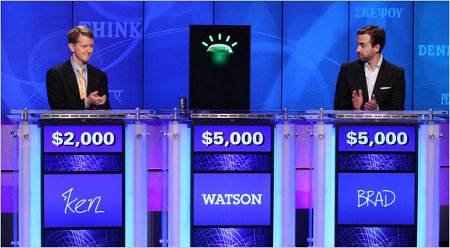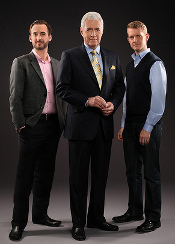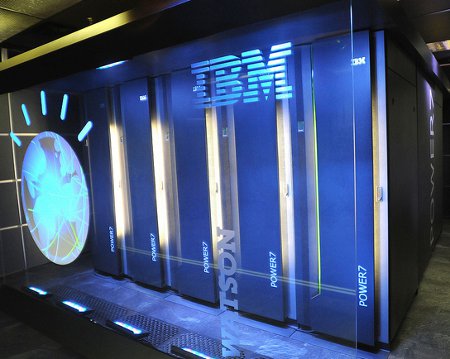IBM’s Linux-based Watson supercomputer wins Jeopardy final
Feb 17, 2011 — by LinuxDevices Staff — from the LinuxDevices Archive — 2 viewsAfter some heady competition from its human rivals in the second exhibition round of Jeopardy, supercomputer “Watson” handily won round three, as well as the competition. Now the SUSE Linux-powered Watson is heading to medical school to prep for a role as a diagnostic assistant, while IBM readies a more context-sensitive successor dubbed “Racr”.
The humans redeemed themselves in the second game of the man vs. machine Jeopardy tournament, after the previous game's debacle, but it wasn't enough. The best Jeopardy player is now a computer named Watson.
Built on a platform of IBM Power 750 servers, running advanced natural language algorithms on Novell's SUSE Linux Enterprise Server, the supercomputer was favored in the contest after besting the same players in a practice round last month.
Watson did not dominate the Feb. 16 finals as thoroughly as it had on the previous night. Ken Jennings (below, left) and Brad Rutter repeatedly beat Watson on the buzzer.

Final Feb. 16 round on Jeopardy
Source: Associated Press
(Click to enlarge)
After Final Jeopardy, which they all answered correctly, the final score was $44,131 for Watson, $19,200 for Jennings, and $11,200 for Rutter.
The first game of the contest on Feb. 14 wasn't even close, with Watson finding both Daily Doubles and running away with $35,734, while Rutter had $10,400 and Jennings $4,800. The total score for the tournament cemented Watson's victory: Watson ended up with $77,147, Jennings with $24,000 and Rutter $21,600.
"What have I learned over the past two days? One, Watson is fast, knows a lot of stuff and can really dominate a match," said Trebek said at the beginning of the game.
However, some of the categories clearly gave Watson some difficulties. It didn't even buzz in on some of them. Watson totally misunderstood the "Also on Your Computer Keys" category, and while it figured out the answers in the "Actors Who Direct" category, it wasn't fast enough to buzz in ahead of the humans.
Confidence game
Throughout the match, Watson's confidence levels w ere frequently drastically low, a dramatic contrast to the first game. On several of the clues, especially in computer keys category in round one and the clothing category in Double Jeopardy, Watson's confidence levels hovered around 20 percent or less.
ere frequently drastically low, a dramatic contrast to the first game. On several of the clues, especially in computer keys category in round one and the clothing category in Double Jeopardy, Watson's confidence levels hovered around 20 percent or less.
While its buzz threshold can change depending on the game state, Watson by default does not buzz in unless it is at least 50 percent confident in the answer, according to IBM researcher Jon Lenchner.
There were also several instances when the correct answer happened to be the third item on its list of possible answers. For the Daily Double clue about a 1959 book, Watson inexplicably answered, "Dorothy Parker," for which it had 14 percent confidence, while the correct answer, "Elements of Style," was offered with a mere 10 percent confidence.
"Watson is capable of some weird wagers," Trebek said.
On its Daily Doubles, Watson wagered $2,127 and $367, respectively. The computer can precisely calculate its confidence level for the category based on what it has figured out about the category, as well as a "game state evaluator" model to estimate its chances of winning based on the other players' scores, number of remaining clues, and value of remaining clues, according to IBM researcher Gerald Tesauro.
Watson departed from its usual conservative bets during Final Jeopardy, wagering $17,973 on the "19th Century Novelists" category. And Jennings, who had joked about needing to either unplug Watson or bet it all during a Daily Double earlier in the game, wagered only $1,000.
Shades of Deep Blue
Watson is powered by 10 racks of Power 750 servers running SUSE Linux Enterprise, containing 15 terabytes of RAM and 2,880 processor cores operating at 80 teraflops. Each Power7 system can run thousands of simultaneous analytics algorithms to sift through more than 15 terabytes of information stored in Watson's "brain." The data is stored in a DB2 database.
Under the "hood," Watson is all open-source, using Eclipse as the tools platform along with Apache's Hadoop and Unstructured Information Management Architecture (an "IBM Research creation") to analyze unstructured data.

IBM's Watson
While many of the most powerful supercomputers in the world are "sons and grandsons" of Deep Blue, the technology remained in very specialized applications, Katharine Fase, vice president of industry solutions and emerging business at IBM Research, told eWEEK. Watson is different in this regard, as the company has been looking at more common applications of Watson' deep Q&A technology.
Next up: Doc Watson and "Racr"
IBM has been pushing health care applications of Watson in various interviews. The company will announce on Feb. 17 a collaboration with Columbia University and the University of Maryland to create a physician's assistant service where doctors will be able to query a cybernetic assistant, according to The New York Times. IBM will also work with Nuance Communications to add voice recognition to the service, which may be available in as few as 18 months, the story said.
IBM has already begun working with computer scientists from around the U.S. on Watson's successor, known as Racr. The name stands for either "reading and contextual reasoning" or "reading and contextual reasoner" (researchers haven't settled on which name to use), according to The Wall Street Journal.
Racr goes a step further beyond what Watson can do, as it would use its database of information to come up with reasoned responses, Eduard Hovy, director of the Information Sciences Institute at the University of Southern California, told the Journal. A Racr model with the ability to learn background knowledge on given topics and then do "reasoning about that" could be reality in five years, Hovy said in the article.
Watson can speedily match parts of speech with information it finds, and then picks the most likely answer. Racr, on the other hand, would pull together interrelated facts to understand the context and derive the most likely answer back on background knowledge. Researchers at IBM and various universities will begin developing machines that can begin to teach themselves, Hovy said in the story.
The company is also in discussions with a "major consumer electronics retailer" for a version of Watson that could interact with consumers to help make buying decisions or offer technical support, IBM executives told the Times.
As Jennings wrote on his Final Jeopardy slate, "I for one welcome our new computer overlords."
Fahmida Y. Rashid is a writer for our sister publication eWEEK.
This article was originally published on LinuxDevices.com and has been donated to the open source community by QuinStreet Inc. Please visit LinuxToday.com for up-to-date news and articles about Linux and open source.